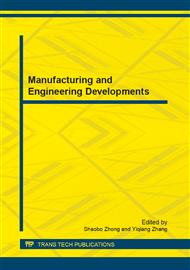[1]
Rajkumar Buyya, David Abramson, Jonathan Giddy, Heinz Stockinger(2002)Economic models for resource management and scheduling in Grid computing[J]. Journal of Concurrency: Practice and Experience, Grid computing special issue 14/13-15: 1507 - 1542.
DOI: 10.1002/cpe.690
Google Scholar
[2]
Rajkumar Buyya, Manzur Murshed, GridSim. 2002. A toolkit for the modeling and simulation of distributed resource management and scheduling for Grid computing[J], Concurrency and Computation: Practice and Experience, 14: 1175-1220.
DOI: 10.1002/cpe.710
Google Scholar
[3]
Rajkumar Buyya, Manzur Murshed, David Abramson, Srikumar Venugopal(2005).
Google Scholar
[4]
Liu Lilan , Yu Tao , SHI Zhan bei, FAN Ming lun(2004) Self-organization Manufacturing Grid and Its Task Scheduling Algorithm [J]. Computer Integrated Manufacturing Systems. 6: 449-455.
Google Scholar
[5]
Liu Lilan, Yu Tao, He Yu'an(2005) A QoS-based GFAM Scheduling Approach for Manufacturing Grid Proceedings of the 2005 The Fifth International Conference on Computer and Information Technology.
DOI: 10.1109/cit.2005.40
Google Scholar
[6]
MA Xue - f en , DA I Xu - dong , SUN S hu - dong, (2004. ) Optimization Deployment of Networked Manufacturing Resources [J] Computer Integrated Manufacturing Systems, 5: 523-527.
Google Scholar
[7]
Raafat Aburukba, Hamada Ghenniwa, Weiming Shen(2007)Agent-Based Dynamic Scheduling Approach for Collaborative Manufacturing, Proceedings of the 2007 11th International Conference on Computer Supported Cooperative Work in Design.
DOI: 10.1109/cscwd.2007.4281477
Google Scholar
[8]
LIU Hai- xia, LI Ren- wang, LI Xue, et al. (2008) Resource scheduling strategy in manufacture grid based on genetic algorithms and simulated annealing[J]. Computer Engineering and Applications, 44( 6) : 234- 236.
Google Scholar
[9]
ZHOU Changchun, YIN Guofu, WU Yingchun, ZHANG Li, OU Yanjiang(2009) Study on the Tactics of Manufacturing Resource Optima l Allocation Oriented to Manufacturing Grid [J]. Journal of Sichuan University (Engineering science edition) , 3: 237-244.
Google Scholar
[10]
D. Burton, Ph.L. Toint(1992)On an instance of the inverse shortest paths problem[J]. Mathematical Programming , Volume 53, Numbers 1-3, 45-61, DOI: 10. 1007/BF01585693.
DOI: 10.1007/bf01585693
Google Scholar
[11]
J. Zhang, Z. Ma, (1996) A network flow method for solving some inverse combinatorial optimization problems[J]. Optimization, 37: 59—72.
DOI: 10.1080/02331939608844197
Google Scholar
[12]
J. Zhang, Z. Liu. (1996) Calculating some inverse linear programming problem[J]. Comput. Appl. Math, 72: 261—273.
Google Scholar
[13]
Michael Ringor, Lech Papiez(1998) Inverse planning and optimization: a comparison of solutions[J]. Radiation Physics and Chemistry, Volume 53, Issue 3 : 263-274.
DOI: 10.1016/s0969-806x(98)00108-x
Google Scholar


